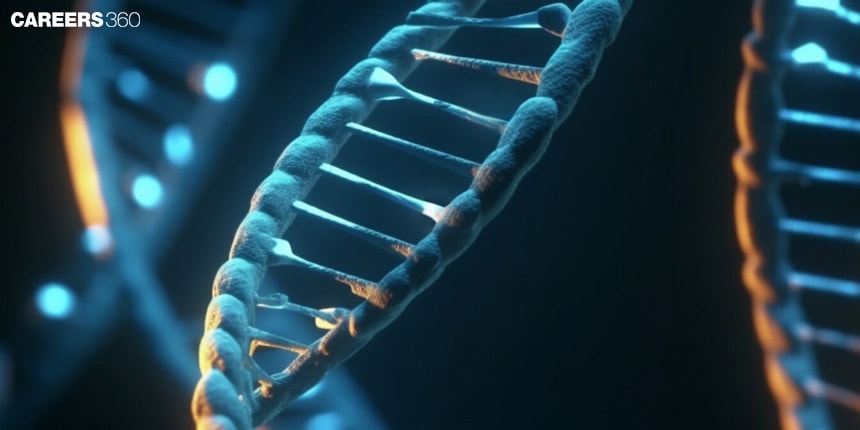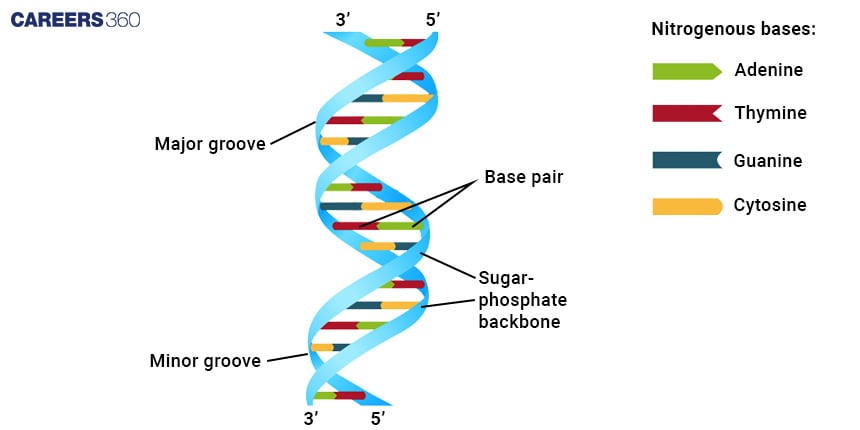Salient Features of Double Helix Structure of DNA: Structure, Features
What Is DNA?
DNA, short for Deoxyribonucleic Acid, is the hereditary material in all known living organisms and many viruses. It has instructions concerning the development, functioning, growth, and reproduction of all known living organisms and many viruses. The information is kept in the DNA molecule as a sequence of nucleotides.
NEET 2025: Mock Test Series | Syllabus | High Scoring Topics | PYQs
NEET Important PYQ's Subject wise: Physics | Chemistry | Biology
New: Meet Careers360 B.Tech/NEET Experts in your City | Book your Seat now
- What Is DNA?
- Discovery Of The Double Helix Structure
- Basic Structure Of DNA
- The Double Helix Model
- Function Of The Double Helix Structure

The structure of DNA is of great importance because it is through the structure that scientists can know genetic information in terms of how it is stored, transmitted, and expressed in living organisms. In other words, understand genetic mutation and how such mutations can be repaired to give rise to advances in medical genetics, biotechnology, and evolutionary biology.
The double helix model of DNA, conceived by James Watson and Francis Crick back in 1953, has revolutionised the science of molecular biology. That is a general description of DNA as two strands coiling around each other in a right-hand helix where every strand consists of nucleotides. It tells of how DNA, through the double helix structure, replicates and stores and transfers genetic information.
Discovery Of The Double Helix Structure
The discovery of the double helical structure of DNA marked one of the big breakthroughs in science, and with the discovery came the hard work of a few key scientists.
James Watson And Francis Crick:
James Watson was an American biologist, while Francis Crick was a British physicist. They are the ones behind the discovery of the double helix structure in 1953, and they proposed a model for the structure, resulting in a Nobel Prize in Physiology or Medicine in 1962, alongside Maurice Wilkins.
Contributions Of Rosalind Franklin And Maurice Wilkins
Rosalind Franklin's contribution to the proceedings was in X-ray diffraction, which proved critical in showing DNA to be helical. Her famous photo 51 gives key evidence to help Watson and Crick build their model. Maurice Wilkins worked on X-ray diffraction as well as on DNA.
Basic Structure Of DNA
The basic structure of DNA has been described below:
Nucleotide Composition
DNA is composed of many nucleotides joined in a chain. Each nucleotide is a complex of three molecules:
Phosphate Group
The backbone of the DNA chain is made up of the phosphate group. The deoxyribose sugars of two nucleotides of a DNA chain are tied together by the boning of their phosphate groups to form a phosphodiester linkage.
Deoxyribose Sugar
Deoxyribose is a five-membered sugar that is a compound in DNA's backbones. A deoxyribose molecule is attached to a phosphate group and a nitrogenous base.
Nitrogenous Bases
The nitrogenous bases are adenine (A), thymine (T), cytosine (C), and guanine (G). These bases are very crucial in storing genetic information.
The Double Helix Model
The double helix structure of DNA consists, in essence, of two strands that run in opposite directions, that is anti-parallel, and twist around each other to form a right-handed helix.
The two strands are clear away from each other but are in opposite directions so that the 5' end of the one strand matches the 3' end of the second strand. It is the antiparallel orientation of the two long polymeric strands winding in a helical form. It is this antiparallel orientation in which the DNA gets replicated and functions. These two strands wind in together symphonically in a right-handed helix so that when looking directly down along the axis of the helix, it twists to the right.
Diagram: DNA Double Helix Structure
Given below is the structure of a double helix DNA showing its components

Function Of The Double Helix Structure
DNA Replication: The double helix structure is very functional in the accurate replication of DNA.
Semi-Conservative Replication Model: During DNA replication, the two strands that make up the double helix unwind from each other. This unwinding opens the two DNA strands and allows them to act as templates for creating new strands; thus, two new double-stranded DNA molecules are created where each molecule consists of one strand that is an original strand of DNA and one strand that is newly synthesised.
Genetic Information Storage and Transmission: It is the string of nitrogenous bases along the DNA string that carries genetic code. Such code is used to synthesise proteins that carry out several functions in a cell.
Mutation and Repair Mechanisms: Errors in the DNA sequence, or mutations, may result from both replication errors and environmental factors. The double helical structure provides the base for the identification and repair of such mutations through several DNA repair mechanisms, thereby maintaining the integrity of the genetic information.
Conclusion
Double helix is a fundamental concept to understand how genetic information is thus preserved, replicated and transmitted through living systems. The discovery of the structure ushered in a fundamentally new way of viewing biology and medicine in the form of genetics and biotechnology. The double helix model remains one of the cornerstones of molecular biology. It has given insight into mechanisms behind heredity, and genetic diseases. It also laid the foundation for the work of genetic engineering and biotechnology.
The Video Recommended For DNA Structure:
Frequently Asked Questions (FAQs)
The double helix structure of DNA is formed by two long chains of nucleotides coiling around each other in a spiral to form a shape. Watson and Crick proposed this structure at the beginning of 1953, after which it provided part of the basis of the genetic information during the heredity and cell function.
In the DNA double helix, there are a pair of these nitrogenous bases: adenine (A) pairs with thymine (T) by two hydrogen bonds, and cytosine (C) pairs with guanine (G) by three hydrogen bonds. The pairs join the two strands to form the double helix.
The double helical structure allows each strand to serve as a template for the production of a new complementary strand. In replication, the strands separate, to enable the semi-conservative process of replication wherein each DNA molecule comprises one new and one old strand.
The understanding of the DNA double helix was significantly advanced by James Watson and Francis Crick's model, Rosalind Franklin's X-ray diffraction images (notably Photo 51), and Maurice Wilkins' collaborative work. These contributions culminated in the accurate depiction of DNA's structure.
The major and minor grooves in the double-strand structure of DNA are the particular regions at which diverse proteins and molecules bind to direct replication, transcription, and repair. This allows specific interactions to act as regulators of genetic activities and maintainers of cellular functions.
Also Read
29 Nov'24 09:31 AM
19 Nov'24 09:26 AM
18 Nov'24 06:45 PM
18 Nov'24 09:29 AM
18 Nov'24 09:18 AM
18 Nov'24 09:01 AM
18 Nov'24 08:37 AM
16 Nov'24 03:45 PM